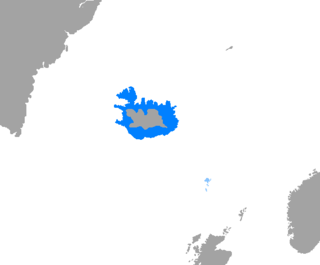Compartmental models are a very general modelling technique. They are often applied to the mathematical modelling of infectious diseases. The population is assigned to compartments with labels – for example, S, I, or R,. People may progress between compartments. The order of the labels usually shows the flow patterns between the compartments; for example SEIS means susceptible, exposed, infectious, then susceptible again.

The Council of Keewatin was an unelected legislative body and territorial government for the now defunct District of Keewatin in Canada. The District of Keewatin was created by the passage of the Keewatin Act on October 7, 1876 from a portion of Canada's North West Territories. Lieutenant Governor Alexander Morris convinced the government that the new territorial government of the North West Territories would be unable to effectively administer land to the north and east of Manitoba. Shortly after the District of Keewatin was formed a large group of Icelanders arrived, infected with smallpox which quickly spread to the indigenous First Nation population. The Government of Canada allowed the Council to be formed for the purpose of containing the smallpox epidemic. The Council also administered Indian treaty claims, immigrant land claims, Hudson's Bay Company trading post concerns as well as policing and health care. The Council lasted from November 25, 1876, until April 16, 1877, after which control of the territory was returned under federal authority.

In Western Europe, the routes of transmission of HIV are diverse, including paid sex, sex between men, intravenous drugs, mother to child transmission, and heterosexual sex. However, many new infections in this region occur through contact with HIV-infected individuals from other regions. In some areas of Europe, such as the Baltic countries, the most common route of HIV transmission is through injecting drug use and heterosexual sex, including paid sex.
Visna-maedi virus from the genus Lentivirus and subfamily Orthoretrovirinae, is a retrovirus that causes encephalitis and chronic pneumonitis in sheep. It is known as visna when found in the brain, and maedi when infecting the lungs. Lifelong, persistent infections in sheep occur in the lungs, lymph nodes, spleen, joints, central nervous system, and mammary glands; The condition is sometimes known as ovine progressive pneumonia (OPP), particularly in the United States, or Montana sheep disease. White blood cells of the monocyte/macrophage lineage are the main target of the virus.
Phaeosphaeria herpotrichoides is a fungal plant pathogen that infects the commercial crops rye and wheat.

Coleosporium tussilaginis is a species of rust fungus in the family Coleosporiaceae. It is a plant pathogen.
Davidiella tassiana is a fungal plant pathogen infecting several hosts, including Iris barnumiae subsp. demawendica in Iran.
Peronospora viciae is a plant pathogen. It is a downy mildew that can infect pea plants. In Iceland it grows on wild Vicia cracca and Lathyrus species.

Puccinia campanulae is a plant pathogen that causes rust on bellflower (Campanula).

Puccinia dioicae is a plant pathogen that causes rust on goldenrod.
Sydowia polyspora is a plant pathogen infecting Douglas firs. In Iceland, it has been reported to infect Larix russica, Pinus contorta and Pinus mugo. and on Rhododendron indicum.
Phoma herbarum is a fungal plant pathogen infecting various plant species, including Alchemilla vulgaris, Arabis petraea, Arenaria norvegica, Armeria maritima, Bartsia alpina, Capsella bursa-pastoris, Erysimum, Euphrasia frigida, Honckenya peploides, Matricaria maritima, Rumex longifolius, Thymus praecox and Urtica dioica.

The Icelandic Basketball Association is the national governing body of basketball in Iceland and is a member of the continental association FIBA Europe and the global International Basketball Federation (FIBA). It directs and oversees all of the national basketball teams of Iceland, including both the junior and senior national teams of both men and women.
Vísir.is is an Icelandic online newspaper. It was founded in 1998 by Frjáls fjölmiðlun ehf and officially opened on 1 April the same year. It originally published news from the newspapers Dagblaðið Vísir, Viðskiptablaðið and Dagur. On 1 December 2017 it was bought by Fjarskipti hf. along with Stöð 2 and Bylgjan from 365 miðlar.

Icelandic is a North Germanic language spoken by about 314,000 people, the vast majority of whom live in Iceland, where it is the national language. Since it is a West Scandinavian language, it is most closely related to Faroese, western Norwegian dialects, and the extinct language Norn. It is not mutually intelligible with the continental Scandinavian languages and is more distinct from the most widely spoken Germanic languages, English and German. The written forms of Icelandic and Faroese are very similar, but their spoken forms are not mutually intelligible.
Phycomelaina is a genus of fungi in the family Phyllachoraceae. This is a monotypic genus, containing the single species Phycomelaina laminariae.
The COVID-19 pandemic in Iceland was a part of the worldwide pandemic of coronavirus disease 2019 caused by severe acute respiratory syndrome coronavirus 2. The virus was confirmed to have reached Iceland in February 2020. As of 4 June 2022, the total number of cases registered was 188,924, of which 153 deaths had occurred. With a total population of about 370,000, the infection rate is about one case per four inhabitants; the infection rate was one of the highest in the world throughout March and April in 2021, though this was attributed to more tests having been carried out per capita in Iceland than any other country, including a screening of the general population run by Icelandic biotech company deCODE genetics to determine the true spread of the virus in the community.
Alma Dagbjört Möller is an Icelandic doctor. On 1 April 2018 she became the first woman to serve as the Director of Health since the office was established in 1760. Since February 2020, she has been one of the lead members of the Iceland's Department of Civil Protection and Emergency Management addressing the COVID-19 pandemic in Iceland.
Events in the year 2020 in Iceland.

Stereocaulon paschale is a species of lichen belonging to the family Stereocaulaceae.







